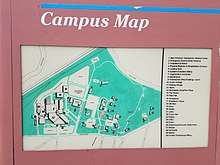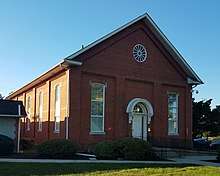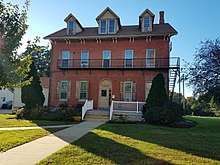Crozer Theological Seminary
|
Old Main | |
|
Old Main Building of Crozer Theological Seminary, November 2009 | |
  | |
| Location | 21st St. and Upland Ave., Upland, Pennsylvania |
|---|---|
| Coordinates | 39°51′21″N 75°22′17″W / 39.85583°N 75.37139°WCoordinates: 39°51′21″N 75°22′17″W / 39.85583°N 75.37139°W |
| Area | 1 acre (0.40 ha) |
| Built | 1857 |
| Architectural style | Italianate |
| NRHP reference # | 73001626[1] |
| Added to NRHP | June 18, 1973 |
The Crozer Theological Seminary was a multi-denominational religious institution located in Upland, Pennsylvania. The school succeeded a Normal School established at the site in 1858 by the weathly textile manufacturer John Price Crozer.[2] The Old Main building was used as a hospital during the American Civil War. The seminary served as an American Baptist Church school, training seminarians for the entry into the Baptist ministry from 1869 to 1970.
Martin Luther King, Jr. was a student at Crozer Theological Seminary from 1948 to 1951 and graduated with a Bachelor of Divinity degree.
In 1970, the seminary merged with the Rochester Theological Seminary in Rochester, New York and the Old Main building was used as office space by Crozer Hospital (now part of the Crozer-Chester Medical Center.) It is a three-story, "F"-shaped, stucco coated stone building. It has three pavilions connected by a corridor with flanking rooms. Each of the pavilions is topped by a gable roof and cupola, the largest cupola being on the central pavilion.[3] The seminary's grounds are now the Crozer Arboretum.
The Old Main building was listed on the National Register of Historic Places in 1973.[1]
History




The Seminary began as the Normal School of Upland, established and built by wealthy textile manufacturer John Price Crozer.[4] After the outbreak of the American Civil War, the school was closed.[5]
Crozer allowed the Union army to use the building as a hospital during the Civil War. The hospital contained a thousand beds and accommodated 300 nurses, attendants and guards. The patients were almost exclusively Union soldiers except for after the battle of Gettysburg, in July 1863, when the number of wounded and sick Confederate army soldiers left on the battlefield required their acceptance at the hospital. During the war, more than 6,000 patients were treated. After the war, the building was repossessed by Crozer and subsequently sold to Colonel Theodore Hyatt for usage as the Pennsylvania Military Academy until 1868.[6][7]
After Crozer's death in 1866, his family converted the school to the Crozer Theological Seminary in his honor. His son recruited faculty for the new mission.[8]
In 1970 the school moved to Rochester, New York, in a merger that formed the Colgate Rochester Crozer Divinity School.[9] The old seminary building was used as the former Crozer Hospital (now the Crozer-Chester Medical Center). The building is currently used as administrative offices for the Crozer-Chester Medical Center.
| Name | Tenure |
|---|---|
| Harry G. Weston | 1869–1909 |
| Milton G. Evans | 1909–1934 |
| James H. Franklin | 1934–1944 |
| Edwin E. Aubrey | 1944–1949 |
| Sankey Lee Blanton | 1950–1962 |
| Ronald V. Wells | 1962–1970 |
Campus
The multi-acre campus contains the Crozer Arboretum and the following buildings:
- Humpstone
- President's House
- Pollard House
- CHEC
- Evans House
- Crozer Hall
- Neisser House
- Lewis House
- Vedder House
- Davis House
- Sunnyside House
- Westin House
- Franklin House
Pearl Hall

Pearl Hall is a serpentine stone library on the campus which opened on June 4, 1871.[10] The building was sponsored by William Bucknell, the benefactor of Bucknell University, in memory of his late wife Margaret Crozer, the daughter of John Price Crozer. In addition to the $30,000 cost of the building, Bucknell also gave $25,000 for the cost of books and $10,000 for an endowment fund.[11]
Notable alumni
- J. Pius Barbour, pastor of Calvary Baptist Church in Chester, Pennsylvania, executive director of the National Baptist Association, editor of the National Baptist Voice, mentor to Martin Luther King, Jr., first African-American graduate of Crozer Theological Seminary
- George Barbier, actor
- Dr. Monroe E. Dodd, pastor of the First Baptist Church of Shreveport, Louisiana from 1912–1950, founder of Dodd College, and a pioneer radio minister
- William Augustus Jones Jr., minister and civil rights leader
- Martin Luther King, Jr., Baptist minister and civil rights leader[12]
- Samuel D. Proctor, minister, educator and humanitarian
Notable faculty
- John Warren Davis, taught Hebrew and Greek for three years
- Lemuel Moss, professor of New Testament
- James B. Pritchard, taught in the chair of Old Testament History and Exegesis
- Henry Clay Vedder, professor of Church history
- W. Kenneth Cauthen, John Price Crozer Griffith Emeritus Professor of Theology, taught at Crozer from 1961-1992.
References
- 1 2 National Park Service (2009-03-13). "National Register Information System". National Register of Historic Places. National Park Service.
- ↑ Jordan, John W. (1914). A History of Delaware County, Pennsylvania, and Its People. New York: Lewis Historical Publishing Company. pp. 462–464. Retrieved 15 October 2017.
- ↑ "National Historic Landmarks & National Register of Historic Places in Pennsylvania" (Searchable database). CRGIS: Cultural Resources Geographic Information System. Note: This includes Pennsylvania Register of Historic Sites and Landmarks (June 1972). "National Register of Historic Places Inventory Nomination Form: Old Main" (PDF). Retrieved 2012-01-06.
- ↑ Ashmeade, Henry Graham (1884). History of Delaware County, Pennsylvania. Philadelphia: L.H. Everts & Co. p. 432. Retrieved 30 July 2017.
- ↑ Cope, Gilbert (1904). Historic Homes and Institutions and Genealogical and Personal Memoirs of Chester and Delaware Counties, Pennsylvania. New York: The Lewis Publishing Company. p. 7. Retrieved 10 March 2018.
- ↑ Cope, Gilbert (1904). Historic Homes and Institutions and Genealogical and Personal Memoirs of Chester and Delaware Counties, Pennsylvania. New York: The Lewis Publishing Company. p. 8. Retrieved 10 March 2018.
- ↑ "Crozer Theological Society". www.uplandboro.org. Retrieved 10 March 2018.
- ↑ Brackney, William H. (2004), A genetic history of Baptist thought : with special reference to Baptists in Britain and North America, Macon, Georgia: Mercer University Press, p. 369, ISBN 978-0-86554-913-5, OCLC 260116581, retrieved 2009-10-06
- ↑ Dugan, George (1970-05-17), "BAPTIST SEMINARY PLANS TO MERGE; Crozer Theological to Join With School in Rochester", The New York Times, p. 36, ISSN 0362-4331, retrieved 2009-10-06
- ↑ Ashmead, Henry Graham (1884). A History of Delaware County, Pennsylvania. Philadelphia: L.H Everts & Co. p. 434. Retrieved 14 October 2017.
- ↑ Jordan, John W. (1914). A History of Delaware County, Pennsylvania, and Its People. New York: Lewis Historical Publishing Company. p. 463. Retrieved 15 October 2017.
- ↑ King, Martin Luther; Carson, Clayborne (1998), The autobiography of Martin Luther King, Jr., New York, New York: Warner Books, p. 62, OCLC 39399036, retrieved 2009-10-06

